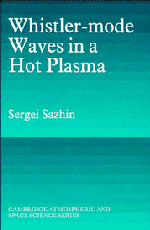Book contents
- Frontmatter
- Contents
- Acknowledgements
- Introduction
- 1 Basic equations
- 2 Propagation in a cold plasma
- 3 Parallel propagation (weakly relativistic approximation)
- 4 Parallel propagation (non-relativistic approximation)
- 5 Quasi-longitudinal approximation
- 6 Quasi-electrostatic approximation
- 7 Growth and damping of the waves
- 8 Non-linear effects
- 9 Applications to the Earth's magnetosphere
- References
- Solutions to the problems
- Index
3 - Parallel propagation (weakly relativistic approximation)
Published online by Cambridge University Press: 30 October 2009
- Frontmatter
- Contents
- Acknowledgements
- Introduction
- 1 Basic equations
- 2 Propagation in a cold plasma
- 3 Parallel propagation (weakly relativistic approximation)
- 4 Parallel propagation (non-relativistic approximation)
- 5 Quasi-longitudinal approximation
- 6 Quasi-electrostatic approximation
- 7 Growth and damping of the waves
- 8 Non-linear effects
- 9 Applications to the Earth's magnetosphere
- References
- Solutions to the problems
- Index
Summary
In contrast to Chapter 2, in this chapter we restrict ourselves to considering the parallel whistler-mode propagation, but impose no restrictions on magnetospheric electron temperature except the condition (1.2) of weakly relativistic approximation. We begin with some general simplifications of the dispersion equation (1.42) with the elements of the plasma dielectric tensor defined by (1.73) in the limiting case θ → 0. In this limit we can assume that ⃒λα⃒ ≡ ⃒k⊥υ⊥/Ωα ⃒ ≪ 1 and expand the Bessel functions in (1.74) using the following formula (Abramovitz & Stegun, 1964).
Remembering (3.1) and keeping only zero-order terms with respect to λα we obtain the following expressions for the non-zero elements of the tensor Πij(n,α) defined by (1.74):
From (1.73) and (3.2) it follows that:
In view of (3.3) and remembering our assumption that θ = 0 we can simplify the dispersion equation (1.42) to
Parallel propagation (weakly relativistic approximation)
This equation can be further simplified if we take into account the contribution of electrons only (which is justified for whistler-mode waves) and present ∈11 = ∈22 as ∈11 = 1 + ∈+ + ∈_ and ∈12 = –∈21 as ∈12 = i(∈+ – ∈_), where ∈+ and ∈_ are the contributions of the electron currents corresponding to n = 1 and n = – 1 respectively in the term ∈11 in (1.73). In this case equation (3.4) can be written as
In order to satisfy (3.5) at least one of three factors in the left-hand side of this equation must be equal to zero. The equation ∈33 = 0 is the dispersion equation for electrostatic Langmuir waves, propagating along the magnetic field (see equation (1.13)).
Information
- Type
- Chapter
- Information
- Whistler-mode Waves in a Hot Plasma , pp. 61 - 75Publisher: Cambridge University PressPrint publication year: 1993
